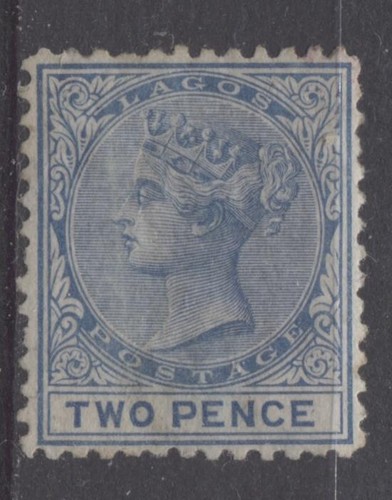Today's post will deal with the second value in this first issue of Lagos, the 2d blue. Four printings were made of this stamp between May 12, 1874 and May 13, 1875.
This post will attempt to explain how to distinguish the four printings of these stamps using the following characteristics:
1. Cancellations.
2. Colour shades.
3. Paper differences.
The discussion in my last post about the significance of the various cancellations used on this issue applies equally to this value as well. I am not going to repeat the details of that discussion here, but will instead provide a link to that discussion:
https://brixtonchrome.com/blogs/nigerian-stamps-and-postal-history/distinguishing-the-six-printings-of-the-1d-lilac-surface-printed-lagos-stamp-with-crown-cc-watermark-and-perforated-12-5
However, the dates found on the Lagos CDS cancellations can be utilized to distinguish the various printings as follows:












This post will attempt to explain how to distinguish the four printings of these stamps using the following characteristics:
1. Cancellations.
2. Colour shades.
3. Paper differences.
The discussion in my last post about the significance of the various cancellations used on this issue applies equally to this value as well. I am not going to repeat the details of that discussion here, but will instead provide a link to that discussion:
https://brixtonchrome.com/blogs/nigerian-stamps-and-postal-history/distinguishing-the-six-printings-of-the-1d-lilac-surface-printed-lagos-stamp-with-crown-cc-watermark-and-perforated-12-5
However, the dates found on the Lagos CDS cancellations can be utilized to distinguish the various printings as follows:
- First printings will be cancelled between June 10 and mid-October 1874.
- Second printings will be cancelled between mid-October 1874 and April 1875.
- Third printings will be cancelled between early April 1875 and June 1875, though some may go quite a bit later.
- Fourth printings will be cancelled from mid-June 1875 and 1876 when they were replaced.
Shades
First Printing:
The stamps of the first printing are printed in blue and deep blue, with the head plate being in pure blue, and the words of value (duty plate) being in deep blue. The shades are very similar, and at first glance, it may appear that the stamp is printed in a single shade of blue. It is the closest match to "blue" on the Stanley Gibbons colour key that I have seen, being neither greyish, or greenish.
The scan below shows a used example of this printing, cancelled July 14, 1874.
Second Printing
The stamps of the second printing were printed in deep blue and deep Prussian blue, with the head plate being printed in deep blue and the duty plate being printed in deep Prussian blue. The difference between the blue on the first printing and the deep blue on these printings should be readily apparent. The blue here is both deeper and brighter, but is still a pure blue. The deep Prussian blue is very close to the deep blue, but has a slight greenish tinge.
The scan below shows an used example of the second printing cancelled on November 22, 1874.
As we can see, the cancellation date is well within the range expected for stamps of this printing.
Third Printing
The stamps of the third printing are printed in deep dull blue and steel blue, with the head plate being deep dull blue, and the words of value (duty plate) being steel blue. The deep dull blue is clearly not as bright as the deep blue of the second printing. It is clearly deeper than the blue of the first printing as well. Steel blue has a slightly greyish tinge to it, and the steel blue here is slightly greyish compared to the blue of the first printing.
The scan below shows a used example of the third printing, postmarked October 11, 1875:
This date is quite a bit later than what we would expect given what I said about the postmarks at the beginning of this post, but I haven't actually seen any third printings dated between April and June 1875. However, I do think that these are the third printing because all the examples of the fourth printing that I have, that bear the barred diamond Lagos grid cancel are printed in different colours from above.
Fourth Printing

The last printings were printed in deep bright blue and Prussian blue, with the head plate being printed in deep bright blue, and the words of value (duty plate) being printed in Prussian blue. On this printing, the deep blue is similar to the deep blue of the second printing, but is slightly brighter. What gives this printing away, is the Prussian blue of the duty plate. It is distinctly greenish in undertone, and while similar to the deep Prussian blue of the second printing, is distinctly lighter.
The scan below shows a used example of a fourth printing cancelled with a diamond grid Lagos grid cancel:
Here is another one, with a CDS cancel dated July 24, 1875, well within the time period that we would expect for fourth printings, based on the dates given above:
Papers
As with the 1d value, the early printings were on crown-CC watermarked paper that shows no distinct mesh, whereas the fine vertical mesh is much more visible on the later printings.
The scan above shows the reverse of a first printing. As you can see, the paper appears smooth, with no distinct mesh. The scan below shows a second printing displaying the same characteristics:
The mesh begins to appear on the third printings, as the scan of a third printing clearly shows:

This continued into the fourth printing as the scan below shows:

This concludes my discussion of the four printings of this value. My next post will look at the 3d red-brown.

